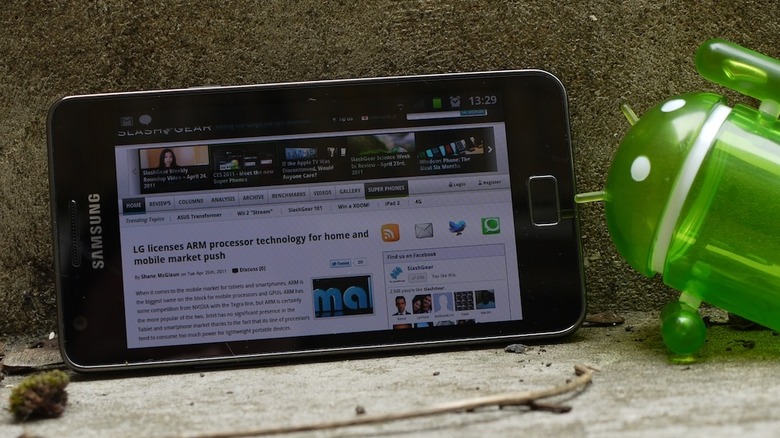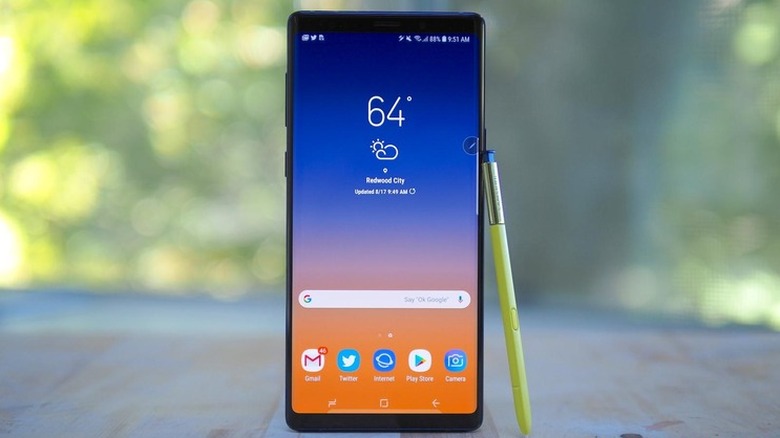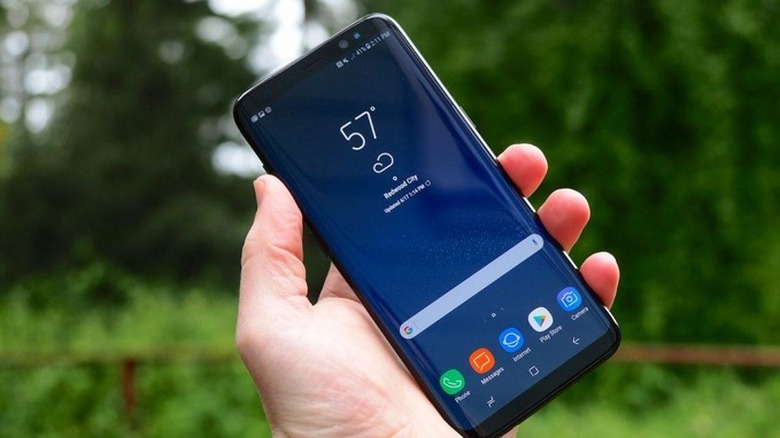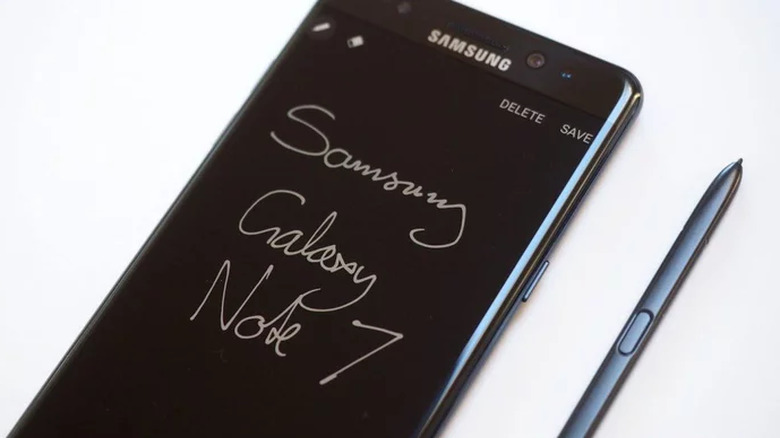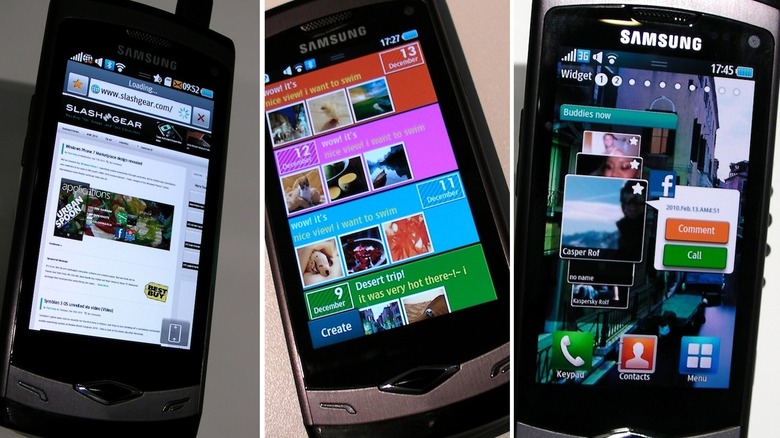

The 5 Best And 5 Worst Samsung Phones Of All Time
source link: https://www.slashgear.com/996541/the-5-best-and-5-worst-samsung-phones-of-all-time/
Go to the source link to view the article. You can view the picture content, updated content and better typesetting reading experience. If the link is broken, please click the button below to view the snapshot at that time.
The 5 Best And 5 Worst Samsung Phones Of All Time
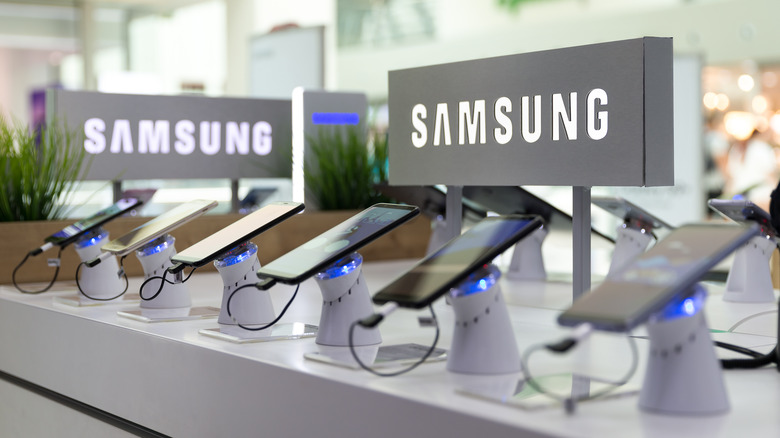
Samsung has become one of the world's biggest phone manufacturers. Along the road, it has had many popular phones, ranging from game-changing foldable phones to the well-loved Samsung Galaxy Note series. There have been many great Samsung phones. As one would expect, though, not all the phones the company has made have been great. There have been some Samsung phones that seemed pretty solid at launch but were plagued by issues later on. On the other hand, there have been Samsung phones that didn't seem too impressive at the time but, in hindsight, have been crucial to Samsung's smartphone success.
Samsung has made a lot of phones which have been deemed worthy of competing with the elusive iPhone. On the other hand, the company has had phones that have quite literally been deemed safety hazards. Samsung has had its share of hits and flops over the years, and both deserve to be revisited. Here's our rundown of the five best and five worst Samsung phones of all time.
Best Samsung phone #1: Samsung Galaxy S II
The follow-up to the legacy-establishing Samsung Galaxy S, the S II was a greatly improved device that was loved by many. It was among the first Android phones touted as a proper iPhone competitor. It wasn't perfect, but as the first sequel of the series, it set the Galaxy S series on a path that helped Samsung make some of the best phones ever made.
The Samsung Galaxy S II arrived at a time when Samsung was just starting to strengthen its position in the market as a serious smartphone maker. As we pointed out in our Samsung Galaxy S II Review, the phone featured a lot of Samsung's strengths. The Super AMOLED display was a standout feature for the time, and the 1.2GHz processor was powerful enough not to make the phone feel sluggish. Both also worked well with the battery of the phone and delivered brilliant battery life.
The S II was a very important phone in Samsung's journey to becoming the smartphone behemoth that it is today, and it is easily the best Samsung phone of all time.
Best Samsung phone #2: Samsung Galaxy Nexus
The Samsung Galaxy Nexus was the only time we got to see Samsung make a Google Nexus device, and it was one of the best Android experiences you could get. With Samsung's finest hardware on offer, combined with "pure" Android — a fresh breath of air from the TouchWiz experience Samsung generally offered — this phone was our first shot at what we would come to call "peak smartphone."
It arrived a few months after the Samsung Galaxy S II, and it was a clear upgrade over the S II. Most importantly, it took care of the biggest problem we had with Samsung phones at the time — TouchWiz UI. Being a Nexus phone, it arrived with the pure Android experience onboard, running Android 4.0 Ice Cream Sandwich. It was an amazing marriage of Samsung's finest hardware and Google's great software. In our Galaxy Nexus Review, we called it the best Android phone around at the time.
We would be lying if we said that the Galaxy Nexus still doesn't make us crave another Samsung phone running Google's untouched Android, even though Samsung's software has greatly improved over the years.
Best Samsung phone #3: Samsung Galaxy Flip 4
Flash forward to the current day; Samsung is now the clear industry leader in Android smartphones. This is well-demonstrated in the company's foldable phones, which are getting so refined that any competition that enters the industry has a high bar to meet. The latest releases in the Galaxy Flip and Fold series set a new standard, with the Flip 4 taking the cake for offering what is possibly the best value in a foldable phone today.
The Samsung Galaxy Flip 4 is the resurrection of the flip phone, except it's now perfected. The hardware, software, and value come together to make it the go-to foldable phone for most people. While foldable phones are still very expensive, the Flip 4 makes for a great value proposition and sits beside other $1000 phones while making very few compromises in the name of the novelty form factor.
In our Samsung Galaxy Z Flip 4 Review, we noted that this phone takes away all the excuses we could give for not buying a foldable phone. It's not perfect, but it is nearing perfection to a point where the compromises typically attached to this new form factor don't matter as much anymore. The Z Flip 4 is a landmark in Samsung's foldable journey and definitely deserves a spot among the best Samsung phones of all time.
Best Samsung phone #4: Samsung Galaxy Note 9
Samsung's Note series has been very important in the evolution of smartphones. Not only did it popularize big phones, but it also brought forth the concept of fully decked-out flagships. The Samsung Galaxy Note 9 was the height of Samsung's Note series. While it hit the $1000 mark, the phone came with a lot of bells and whistles. A great phone for productivity with the notetaking features and Samsung DeX, this phone went all out.
In our Samsung Galaxy Note 9 Review, we called it a supercar smartphone, which is still apt four years later, even as the Note series is no more. It was among the first phones that tried to pack in every bit of performance possible and went the extra mile. Of course, this was reflected in its eye-watering price, but $1000 phones are fairly common today. This phone had very little you could fault. It even came with a semi-exclusive Fortnite skin, if that was your thing.
The fully decked-out smartphone that truly kicked off with the Samsung Galaxy Note 9 has today become a common offering, and although the Samsung Note lineup is dead, Samsung keeps the dream alive with its Ultra phones.
Best Samsung phone #5: Samsung Galaxy S8
The last phone on our list of the best Samsung phones is another S series phone, and for a good reason. Samsung's S series has had a lot of ups and downs over the years, but the S8 is where the series peaked. This was the second-last phone in the series that had the base model carry more or less the same specifications as the Plus model — no Ultra needed. It was so refined that no base model in the Galaxy S series since has managed to pack in the same punch or value.
The highlight of the Samsung Galaxy S8 was the gorgeous curved 1440p Super AMOLED screen which had just the right amount of curvature. It was a fantastic phone to hold, with a hand feel that is still unmatched. The 5.8-inch screen meant the phone was quite easy to handle. While the base models of Samsung's S series still offer good value, they have some very obvious compromises over the Plus and Ultra models. The S8 was so good that the S9 changed very little and still managed to be a great phone.
In our Samsung Galaxy S8 Review, we labeled it as a "tremendously good phone." We also said that the phone had set Samsung's highest bar ever for its competitors, especially the iPhone. To this day, the S8 remains a dream phone come true, and we wish Samsung brings back the small flagship someday in the near future.
Worst Samsung phone #1: Samsung Galaxy Note 7
When it comes to listing the worst Samsung phones of all time, the top choice is a no-brainer. There's no other contender that comes even close to this one. The Samsung Galaxy Note 7 had a major battery issue, leading to it spontaneously combusting and subsequently being banned from flights. It was one of the worst public smartphone fiascos in history, courtesy of it being a genuine safety risk. We did a deep dive into exactly what caused the risk that led to these issues, and there was no doubt that these design flaws made the Samsung Galaxy Note 7 an easy pick for the worst Samsung phone ever.
The unfortunate thing is, outside of that deal-breaker battery issue, it wasn't even a bad phone. Without the battery issue, this device was set to be the best Android phone of 2016. In our Samsung Galaxy Note 7 Review, we pointed out how there wasn't much to dislike about the phone. That was, of course, the case until the battery fires started. This phone almost permanently damaged Samsung's reputation, but the company managed to make a comeback.
The Samsung Galaxy Note 7 is easily one of the worst phone launches of all time. Samsung's follow-up phones have not had these kinds of issues — at least not at this level — although other issues qualify the rest of the phones below to be on this list.
Worst Samsung phone #2: Samsung Galaxy Fold
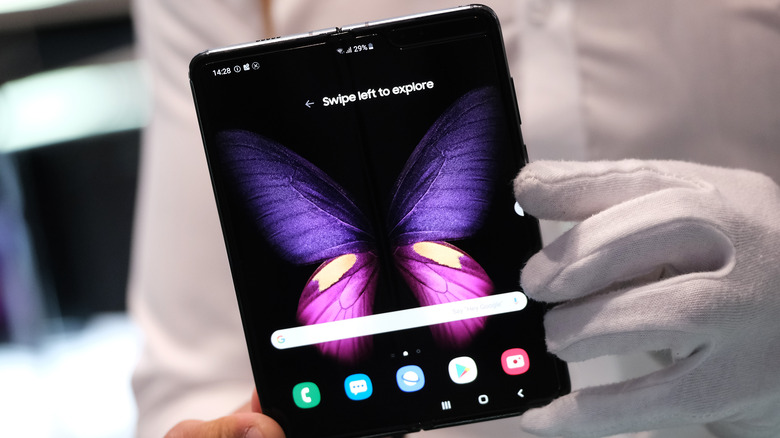
While the Samsung Galaxy Fold series has been a game-changing series of innovations in the smartphone world, it has had more than its fair share of growing pains. The original Samsung Galaxy Fold is on this list because, despite kicking off the foldable phone segment, it had a lot of issues that made it a really poor purchase for actual customers.
While not bad on paper, Samsung's first shot at a foldable phone was all but smooth. The phone had to be delayed due to defects in review units that ended up breaking the screen. Even after the delayed launch, the phone was deemed fragile and carried serious durability compromises thanks to the new and unperfected form factor. The weird notch on the inner screen also stuck out like a sore thumb.
The Verge's review of the Samsung Galaxy Fold review also pointed these issues out, knocking the phone for its obvious fragility. It also noted that the issue wasn't quite as bad as the Note 7 fiasco, but still bad enough not to recommend this phone. Samsung has improved the durability of these phones, but the original Fold remains one of the worst Samsung phones.
Worst Samsung phone #3: Samsung Wave S8500
The Samsung Wave S8500 is a real throwback, and unlike most phones in this list, this phone was a colossal failure when contextualized with today's smartphone landscape. It came with some decent hardware, but it was the software that made this phone a failure. It had Samsung's Bada OS on board, which simply failed to compete with Android due to its lack of features. This phone ended up being a feature phone in a smartphone's clothing and killed whatever shot Samsung had at its mobile operating system.
We have seen the iOS-Android duopoly for years now, and Samsung's Bada OS could have avoided that. Bada OS had a rocky journey, but the Samsung Wave was the nail in the coffin for Samsung's hopes of having its own smartphone OS that could compete in the market. In our Samsung Wave S8500 Review, we said it was a phone in two halves — one being the great hardware and the other being the underwhelming software.
The Samsung Wave S8500 arrived quite early on when feature phones were still relevant and smartphones were just starting to show up. It had great potential, but Samsung's terrible approach with the software makes this one of the worst Samsung phones ever.
Worst Samsung phone #4: Samsung Galaxy S4
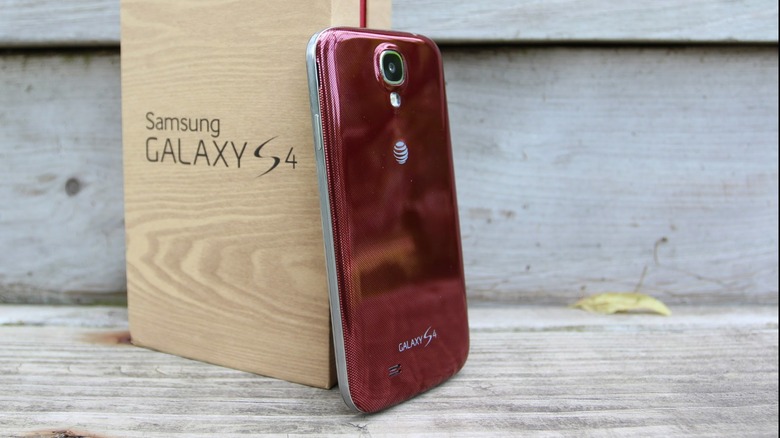
The Samsung Galaxy S series has had a lot of hits and a lot of duds, and the Samsung Galaxy S4 is a bit of both. It's one of the best-selling phones of all time and yet one of the most boring Galaxy S phones of all time as well. Samsung piggybacked on the success of the Galaxy S3, a pretty great phone, to sell the Galaxy S4.
The Samsung Galaxy S4 wasn't a bad phone for the time, but it is definitely one of the less impressive phones in the range. A follow-up to the well-loved Samsung Galaxy S3, it arrived looking like a poor upgrade over the last generation. It was seen as a safe bet, but it had its fair share of issues and didn't feel nearly as premium as the competing HTC One. The plastic build, coupled with the poor haptics, made this phone feel quite cheap.
In our Samsung Galaxy S4 Review, we had predicted that this phone would be a best seller. At the same time, we had pointed out our issues with the build, the cameras, and the battery life. Despite the cash cow that the S4 was, it still earns a spot on this list.
Worst Samsung phone #5: Samsung Galaxy S6
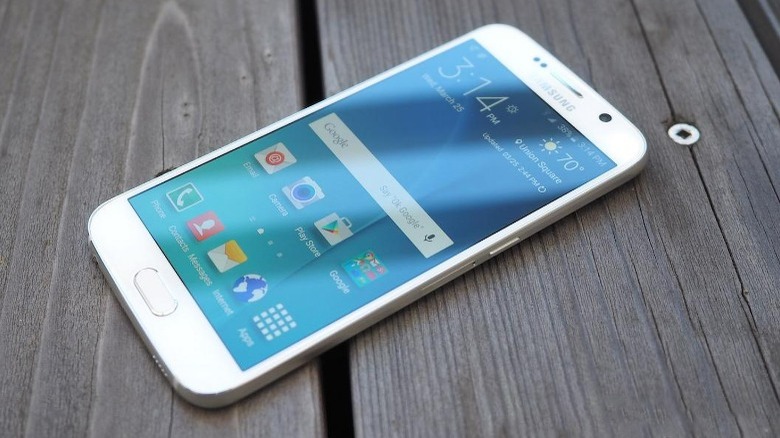
After the Samsung Galaxy S4, Samsung made the S5, which was more of the same. After the company realized it had to shake things up, the Samsung Galaxy S6 arrived as quite a different kind of package, which looked great at first sight. However, this upgrade was plagued with issues, and despite the pretty looks, it failed to deliver a phone worth recommending.
The Samsung Galaxy S6 was a decidedly upgraded iteration over the S5, especially in terms of design, but it made a few compromises, including a missing IP rating, a smaller, non-removable battery, and the lack of a microSD card slot. Not just that, Samsung also bumped up the price to match Apple's pricing for the iPhone. Having an Edge model that was better-looking didn't help its case, either.
In our Samsung Galaxy S6 review, we pointed out how the phone's appearance was not enough but said the phone was still a good iteration over its predecessor. Looking back, however, the Samsung Galaxy S6 is easily one of the worst Samsung phones ever, especially when you look at the other phones the company has made.
The Best Smartphones Of 2021 Ranked
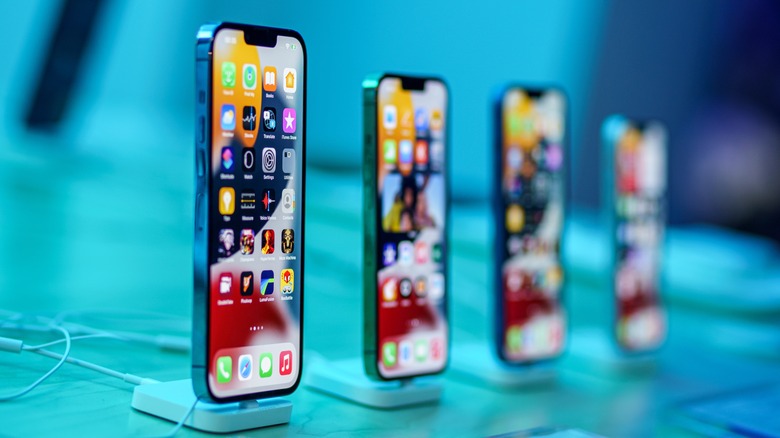
The smartphone market has someone for everyone, whether you're looking for a budget device that doesn't compromise on features or a flagship model sporting the latest and greatest hardware. Despite chip shortages, shipping delays, and production bottlenecks, manufacturers still managed to deliver an assortment of new handsets in 2021, including these top-of-the-line models.
1. iPhone 13
Love it or hate it, Apple makes great products. Samsung was a strong competitor this year, launching high-end smartphones of both the folding and non-folding variety, but the company still hasn't managed to outdo Apple at what Apple does best: offer a tightly integrated, cohesive, and highly useable ecosystem that seamlessly blends its own hardware, software, and services.
Buying an iPhone is more than just selecting iOS as your mobile operating system of choice. The handset works seamlessly with the Apple Watch, which itself still trumps anything you can get sporting Wear OS. In the same way, the iPhone works well with the iPad — which, again, exceeds any other tablet you can get for the simple reason that Android is entirely lacking on slates.
You don't have to buy into the wider Apple ecosystem to get the iPhone, of course, and it's possible the iPhone lacks a key feature you can't live without, whether that's a microSD card slot, built-in stylus, or 3.5mm audio jack. If you're content with a phone that doesn't include those finer trimmings, however, the iPhone 13 is worth serious consideration if you're looking for a high-end upgrade.
The iPhone 13 line is comprised of the iPhone 13 mini, iPhone 13, iPhone 13 Pro, and iPhone 13 Pro Max. These models range in size from 5.4-inches to 6.7-inches, with the best features being found in the two Pro options.
The iPhone 13 Pro packs a Super Retina XDR screen with ProMotion and Ceramic Shield, an IP68 water resistance rating, Apple's A15 Bionic chip, 5G support (including mmWave), ultra-wideband for using things like digital keys, Bluetooth 5, WiFi 6, and gigabit LTE.
Apple put a lot of focus on the cameras and related software with the iPhone 13 Pro. In terms of hardware, buyers get a "Pro" 12-megapixel camera system that includes wide, ultra-wide, and telephoto cameras. That is joined by the 12-megapixel TrueDepth camera on the front of the handset, which also powers the Face ID feature.
These cameras are joined by a variety of software features, including Apple's new "Cinematic mode" for recording movie-like videos. This new mode includes support for the TrueDepth, wide, and telephoto cameras, as well as Dolby Vision HDR.
The iPhone 13 Pro's camera features also include 6x optical zoom, 3x optical zoom for the telephoto lens specifically, support for macro video recording, improved low-light performance, "Photography Styles," and what Apple describes as an end-to-end workflow directly on the phone that includes editing in ProRes and Dolby Vision.
Not interested in Apple products? Fortunately, several excellent Android alternatives were released this year.
2. Galaxy S21
Samsung's Galaxy line has been around for years and there's a reason it has remained so popular. The latest and greatest installment in the series, the Galaxy S21, offers a huge number of features, but at a price not all consumers are willing to embrace. If cost isn't an issue for you, check out the Galaxy S21 Ultra 5G, the top model in the new line.
The Galaxy S21 Ultra 5G has a huge 6.8-inch Quad HD+ Dynamic AMOLED 2X Infinity-O display with 3200 x 1400 pixel resolution, giving it a pixel density of 515ppi (pixels per inch). Notable features include HDR10+ certification, a 120Hz refresh rate, a 40-megapixel "hole-punch" selfie camera, four rear cameras (10-megapixel telephoto F2.4 and F4.9 units, 108-megapixel wide-angle, and 12-megapixel ultra-wide), as well as a pressure-sensitive S Pen.
In addition to the LTE and 5G connectivity, the model also supports up to 2.4Gbps download speeds, offers Bluetooth 5.2, and includes ultra wideband (UWB) support for digital keys. The model is powered by the Snapdragon 888 alongside 12GB RAM and 512GB internal data storage.
The S21 Ultra packs a bunch of hardware capabilities and software features targeting what consumers are often most interested in. This model's camera features are particularly notable with things like 100x "space zoom," a 40-megapixel camera combined with software that produces what Samsung claims are "studio-quality portraits," and support for shooting videos in 8K resolution.
The S Pen inclusion takes the S21 Ultra to the next level with tablet-like functionality, making it easier to handle a wide variety of advanced features – like editing videos and photos directly on the device. This is the first Galaxy model to pack a 5nm processor, enabling faster performance — including when it comes to AI-powered features — compared to previous models.
The 5000mAh battery combined with some efficiency features gives users a runtime beyond a full day (though it largely depends on how the device is used), plus there are convenience features like wireless PowerShare for charging, for example, a pair of true wireless earbuds with wireless charging support.
The powerful hardware, sophisticated software, and well-rounded array of features make the S21 Ultra one of the top smartphones on the market right now, though its price will be the biggest issue for many consumers. The Galaxy S21 5G (the one with the 6.2-inch display) starts at $799.99, but making the jump to the Ultra 5G model pushes the starting price to $1,200. There are some ways to reduce the price, including trading in certain devices for a substantial discount, but the final price will still likely be substantial.
3. Pixel 6
Though Google's Pixel has never managed to grab a significant share of the smartphone market, the company continues to update the line, arguably using its own hardware as a way to showcase Android in its purest form.
The Pixel 6 was released this year as the latest major installment in the smartphone family, bringing key features like Google's Tensor chip, the Titan M2 security chip with five years of updates, two rear camera, and what Google calls an adaptive battery that optimizes energy use so consumers can go longer between charging sessions.
Google historically offered a single camera with its Pixel smartphones, electing to enhance its mobile camera capabilities with software. This is known as computational photography, which utilizes artificial intelligence and software to improve the raw image data captured with the Pixel's camera. It was inevitable that Google would eventually increase the number of cameras included on its handsets, however, and the Pixel 5 marked the first time a model in this line was released with a dual-camera system. The Pixel 6 continues this trend with its own dual-camera array.
The Pixel 6 packs larger camera sensors compared to the previous model, which, among other things, enables the phone to gather 150-percent more light for brighter, higher-quality images in lower-light environments. This latest flagship model includes an ultra-wide lens for capturing larger scenes.
The software magic remains, including some features that would otherwise require you to fire up Photoshop. Magic Eraser is one excellent example: it resides on Google Photos and works by removing unwanted objects and people from images. Portrait Mode offers a blurred background for higher-quality selfies, plus there's Motion Mode for more dynamic action shots in environments with a lot of movement.
The model packs other notable features, including support for 5G networks, real-time language translations integrated into things like chat and podcast captions, an IP68 rating against dust and water exposure, and a high refresh rate for what Google calls "Smooth Display." Though you won't get a stylus like the one offered with the S21 Ultra, the Pixel 6 comes with some of its own perks, the best being its regular software updates known as feature drops.
Adding to the appeal is the somewhat lower price tag accompanying the Pixel 6; an unlocked version of the device with 128GB starts at $599, while the 256GB model starts at $699, making it a more economical choice for consumers who want high-end features and a bunch of storage space while staying well below a $1,000 price point.
4. Galaxy Z Flip 3
Many consumers aren't ready to embrace the foldable evolution yet, but this year brought a couple of excellent options for those who can't wait any longer. Samsung's Galaxy Z Flip 3 is the latest installment in the company's foldable product lines; this is the version that folds like an old-school clamshell flip phone, not to be confused with the book-style Galaxy Z Fold 3.
The Galaxy Z Flip 3 beats out the Z Fold 3 on this list for one simple reason: it is cheaper and, with the right trade-in device, the price can be dropped down to a very comfortable $325 or so. The model's defining feature is its flexible display, enabling the smartphone to fold in half horizontally across the body.
When unfolded, the Galaxy Z Flip 3 has a 6.7-inch screen; the device looks like a long, ordinary high-end smartphone. When folded, however, the length drops to just over 3-inches with a width a bit over half an inch. The screen packs a Full HD+ (2640 x 1080) Dynamic AMOLED panel with Infinity Flex Display, a 22:9 aspect ratio, 120Hz adaptive refresh rate, and 425ppi.
This main display is joined by a small 1.9-inch Super AMOLED screen on the rear of the device that shows basic details when the phone is folded. This rear display has a 260 x 512 resolution. The model packs many features you'd expect in a flagship model, including a 10-megapixel front-facing camera, while the rear camera array includes two 12-megapixel ultra-wide cameras, one with optical image stabilization, dual pixel autofocus, 78-degree field of view, and an F1.8 aperture. The other ultra-wide camera has an F2.2 aperture and a much wider 123-degree field of view.
The unique form factor aside, the Galaxy Z Flip 3 brings many of the same features you'd get on Samsung's other flagship handsets, including wireless charging, fast charging support, 5G connectivity, nano-SIM and eSIM, stereo speakers, and an array of sensors (accelerometer, proximity, etcetera). Other notable offerings include a 5nm processor, 8GB of RAM, up to 256GB of storage, Bluetooth 5.1, USB-C connectivity, a 3300mAh battery, and support for recording up to 4K videos.
5. OnePlus 9
This year brought the latest and arguably greatest OnePlus flagship, the OnePlus 9. Note that we're talking specifically about the US version of this phone; the model is available in other markets, as well, and its exact features may vary a bit depending on where it is purchased.
The OnePlus 9 features a 6.55-inch Fluid AMOLED display with a 120Hz refresh rate, 20:9 aspect ratio, and 2400 x 1080 resolution. The handset is powered by the Snapdragon 888 and it runs OnePlus's OxygenOS based on Android 11. Storage and memory are notable at 128GB/8GB, while the battery is on the large end of the spectrum with a 4500mAh capacity (fast charging is supported).
The handset packs a main 48-megapixel camera with a Sony IMX689 sensor and an F1.8 aperture lens; this is joined by an ultra-wide 50-megapixel model sporting the Sony IMX766 sensor and an F2.2 aperture lens. Interestingly enough, OnePlus also includes a 2-megapixel monochrome camera, which is a relative rarity among smartphones (Huawei included something similar with its P20 Pro and P10 models).
The camera features are extensive, including support for recording in 4K at 60fps and 8K at 30fps, plus there's slow-motion at up to 480fps, support for capturing time-lapses in 4K resolution, and there's a dual-LED flash. The front camera, meanwhile, skews toward an average offering at 16-megapixels with electronic image stabilization, fixed focus, and an F2.4 aperture.
Consumers looking for a bit more can check out the OnePlus 9 Pro variant, which boosts the features with a similar uptick in price. This model packs a more notable 6.7-inch Fluid AMOLED display with LTPO, 120Hz refresh rate, 3216 x 1440 resolution, 20.1:9 aspect ratio, and 10-bit color depth.
The model is likewise powered by a Snapdragon 888 alongside an X60 chipset for 5G connectivity. Storage and memory are higher at 256GB/12GB, respectively, while the battery sits at 4500mAh with fast charging support and 50W wireless charging.
The cameras are likewise upgraded with a 48-megapixel main camera packing optical image stabilization and an F1.8 aperture, a 50-megapixel ultra-wide camera with a freeform lens, an 8-megapixel telephoto camera with optical image stabilization, and the same 2-megapixel monochrome camera found on the non-Pro version.
The OnePlus 9 Pro is the one you'll want to consider if you're looking to upgrade to a model you'll keep for a while. The price is high at $1,069, though OnePlus currently lists the model at a discounted $849. Consumers in the US have two options: an unlocked model they can take to their favorite carrier or a T-Mobile version that runs on the provider's network.
6. Galaxy Z Fold 3
One of the most interesting Android smartphones released this year is also the most expensive: Samsung's massive book-style Galaxy Z Fold 3 foldable. This model has a 7.6-inch Infinite Flex Display, essentially making it a small tablet when unfolded; the screen is a more typical 6.2-inches when folded.
Given that the Z Fold 3 is essentially a hybrid device that sits between a smartphone and tablet, it's no surprise Samsung offers S Pen Pro and S Pen Fold accessories, enabling users to draw and write on the display the same way they would a Note device or a Samsung tablet.
The model packs an IPX8 water resistance rating, which means the device can handle exposure to water to depths of up to 5ft for up to half an hour. The latest Fold is powered by a Snapdragon 888 octa-core processor; it packs up to 512GB of storage and 12GB of memory, a 4,400mAh battery, and a 120Hz adaptive display refresh rate.
The camera array is notable with three units on the back: a 12-megapixel wide-angle, 12-megapixel ultra-wide-angle, and 12-megapixel telephoto cameras. The front, meanwhile, sports two cameras: a main 4-megapixel unit and a 10-megapixel front cover camera.
The camera loadout isn't as impressive as what you get with the S21 Ultra, but the device's main purpose resides in its unique form factor, not its photo capabilities. Samsung leverages the ultra-wide display by offering unique multi-tasking features, delivering what the company refers to as "PC-like productivity" — though, keep in mind that only some apps support the Flex mode.
The Galaxy Z Fold 3 is a productivity powerhouse, targeting consumers who often do business and get work done directly on their handsets. The tablet-like form factor enables users to leave their dedicated tablets at home, instead unfolding their smartphone to markup documents, sign paperwork, edit videos, and other tasks that are more difficult on smaller traditional form factors.
There's one huge downside to this model, however, and that is its astronomical price tag. With a starting price of $1,900 unlocked, that makes the phone more expensive than many nice ultrabook laptops and, for example, the 12.9" iPad Pro with 1TB of storage.
Consumers are very much paying for the novelty of having a large folding smartphone, one that, while still excellent, isn't going to stand up against something like an M1 iPad Pro when it comes to performance, app variety, and the user interface. For this reason, buyers should be mindful of what they truly need out of a mobile device and whether the Galaxy Z Fold 3 is able to meet those needs.
If you decide to pick up a model, keep in mind that Samsung will drop the price to $849 USD with certain trade-ins, plus it includes the Galaxy Buds 2 for free with the purchase (if you buy the device directly from Samsung's website, at least).
7. Huawei P50 Pro
Last but not least is the Huawei P50 Pro, a high-end smartphone the company released this year with one massive problem: it doesn't run Android. This may be a dealbreaker for many consumers, but if you don't mind being limited to Huawei's HarmonyOS, there's a lot to like about this flagship model.
The Huawei P50 Pro sports a 6.6-inch OLED display with a 120Hz refresh rate and 2700 x 1228 resolution. The model is powered by the Snapdragon 888 4G alongside Adreno 660 graphics; there's 8GB/256GB memory and storage, respectively, as well as a 4360mAh battery with fast and wireless charging support.
Huawei focused extensively on the P50 Pro's camera array with four units on the back: a 50-megapixel "True-Chroma" module packing optical image stabilization, a 40-megapixel True-Chroma F1.6 module, a 13-megapixel ultra-wide-angle F2.2 module, and a 64-megapixel telephoto camera with optical image stabilization, autofocus, and F3.5 aperture. The cameras include phase focus and contrast focus options, plus there's hybrid and digital zoom for those times when the optical zoom isn't enough.
The camera hardware is paired with a variety of software-based features, including an AI-powered "Cinemagraph" mode, 4K Predictive Focus, time-lapse shooting, audio zoom, macro and portrait modes, monochrome camera capture, Moving Picture, and more. The front-facing camera, meanwhile, includes a 13-megapixel wide-angle module combined with software features like smart eye tracking, panorama, AR lenses, and slow-motion selfie capture.
Other notable features include an IP68 rating, meaning the phone has a degree of resistance against dust and water, plus there's a dual-SIM version of the handset with 4G LTE support, Bluetooth 5.2, USB-C connectivity, NFC, GPS, and the typical array of sensors found on flagships (fingerprint, gravity, infrared, gyroscope, ambient light, etcetera).
Again, the big downside here is the P50 Pro's lack of Android and Google services; users are instead given access to Huawei's own HarmonyOS, which, while nice, comes with far fewer app options than the average consumer is used to. You may not be able to download your favorite apps, and that could be a big deal, particularly if you need certain unsupported apps for work. Speaking of work, depending on the industry, you may not be allowed to use a Huawei handset for business purposes due to security rules.
Given the P50 Pro's high price (around $1,200 USD, depending on configuration) and its many downsides, it's really not advisable for someone outside of China to purchase the model — there are alternatives like the S21 Ultra that come in around the same price point with many of the same or similar features, but with Android and Google services. With that said, the P50 Pro — from a hardware standpoint — is still one of the most notable flagships released in 2021.
Recommend
About Joyk
Aggregate valuable and interesting links.
Joyk means Joy of geeK
